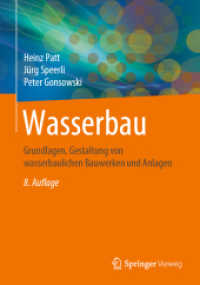Full Description
This book discusses theories that link functions to specific anatomical brain regions. The best known of these are the Broca and Wernicke regions, and these have become synonyms for the location of productive and receptive language functions respectively. This Broca-Wernicke model has proved to be such a powerful concept that is remains the predominant view in modern clinical practice. What is fascinating, however, is that there is little evidence for this strictly localist view on language functions. Modern neuroscience and numerous clinical observations in individual patients show that language functions are represented in complex and ever-changing neural networks. It is fair to say that the model is wrong, and that Broca's and Wernicke's areas in their classic forms do not exist.
This is a fascinating paradox: why do neurologists and neurosurgeons continue to use these iconic language models in everyday decision-making? In this book, the author uses his background as a neurosurgeon and a neuroscientist to provide some answers to this question.
The book acquaints clinicians and researchers with the many different aspects of language representation in the brain. It provides a historical overview of functional localisation, as well as insights into the misjudgements that have kept the localist doctrine alive. It creates an awareness of the need to integrate clinical observations and neuroscientific theories if we want to progress further in clinical language research and patient care.
Contents
0. PREFACE.- Personal experience.- What we can learn from (everyday) patient cases.- Classical authors with modern opinions.- 1. BROCA & THE BIRTH OF LOCALIZATION THEORIES.- Gall.- Flourens.- Bouillaud & Broca.- 2. WERNICKE & CONNECTIONISM.- Meynert.- The symptom-complex of aphasia, part I.- The symptom-complex of aphasia, part II.- The symptom-complex of aphasia, part III.- 3. APHASIA AND/OR AGNOSIA ?.- Lissauer.- Freund.- 4. THE DIAGRAM MAKERS AND THEIR CRITICS.- Lichtheim.- Kussmaul.- Hughlings Jackson.- Freud.- Marie, Head & the decline of localism.- 5. NAMING AND NUMBERING THE CONVOLUTIONS.- Ecker, Leuret & Gratiolet: order out of chaos.- Microscopic carthography.- Brodmann & Campbell's view on Broca's area.- Language areas defined in terms of gyri and sulci.- The planum temporale.- Some concluding remarks.- 6. MAPPING AND LESIONING THE LIVING BRAIN.- Fritsch & Hitzig.- Ferrier.- Sherrington: the primate motor strip.- Krause, Foerster &Penfield : the human motor strip.- Bartholow & Cushing: first experiences from conscious patients.- Penfield's speech and brain mechanisms.- Ojemann: expanding the language territory.- Duffau: subcortical pathways & hodology.- Electrical stimulation mapping: gold standard.- 7. NEO-CONNECTIONISM, NEURODYNAMICS & LARGE-SCALE NETWORKS.- Geschwind.- Luria.- Computational models & parallel processing.- Language and evolution.- Homologue language areas in non-human primates.- More recent language models: Mesulam, Hickok & Poeppel.- The phonological loop.- 8. FUNCTIONAL NEUROIMAGING.- Early landmark studies.- Beyond single word processing.- A comparison to classic language models.- Intersubject variability.- The problem of averaging.- Hemispheric dominance.- 9. NEURAL PLASTICITY & REHABILITATION.- Early studies.- Diaschisis.- Equipotentiality.- Lashley.- Critical period.- 10. BEYOND LANGUAGE FUNCTIONS.- 11. SYNOPSIS.








